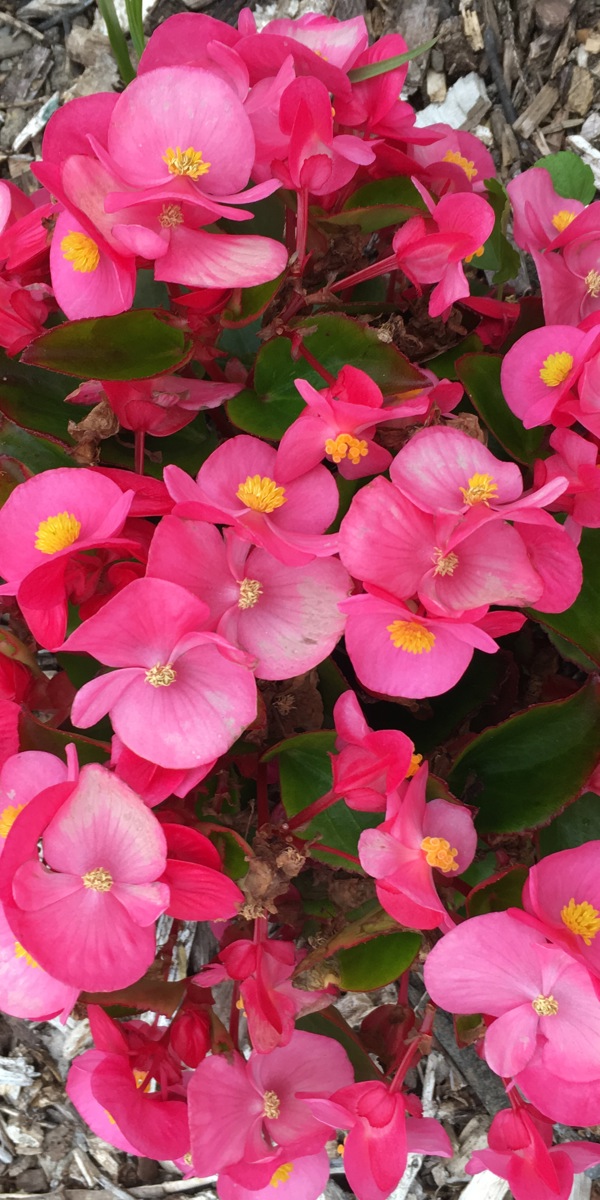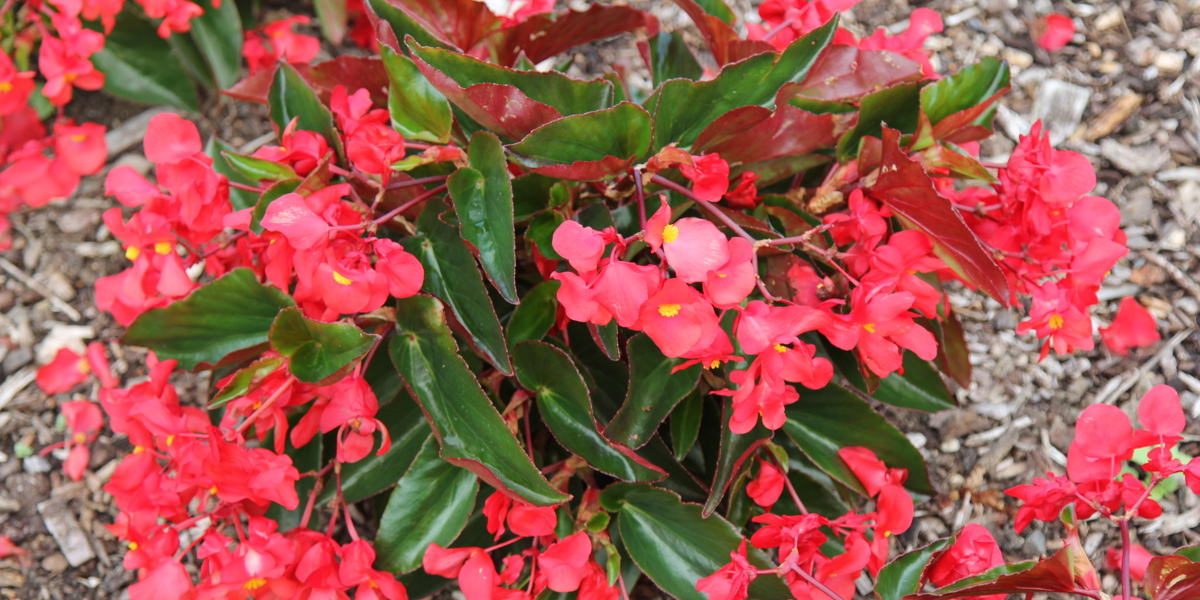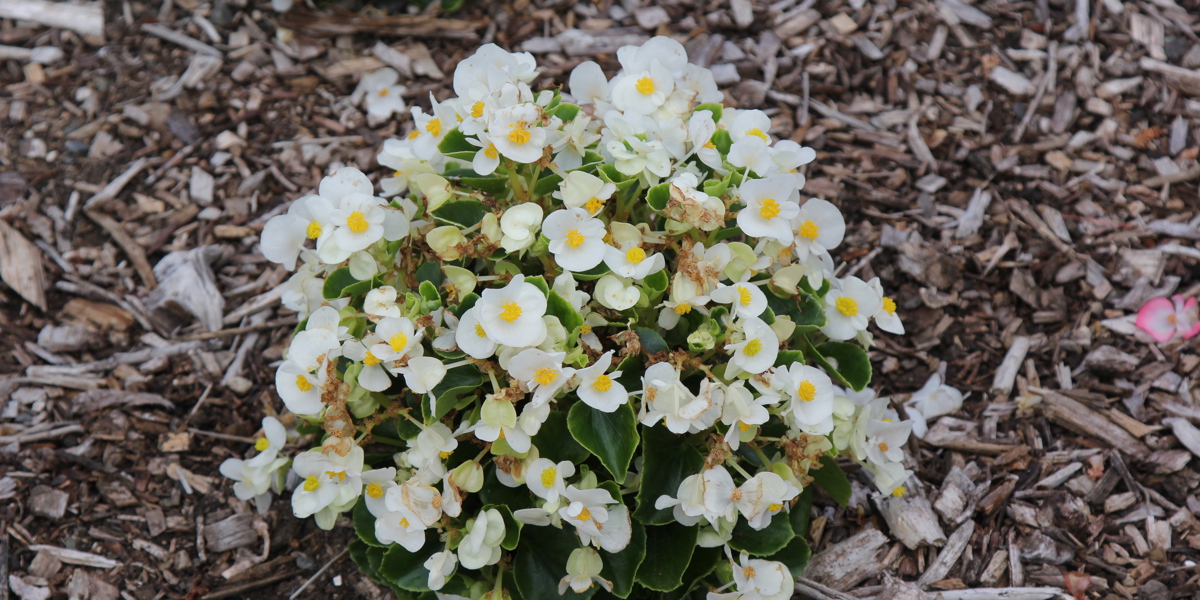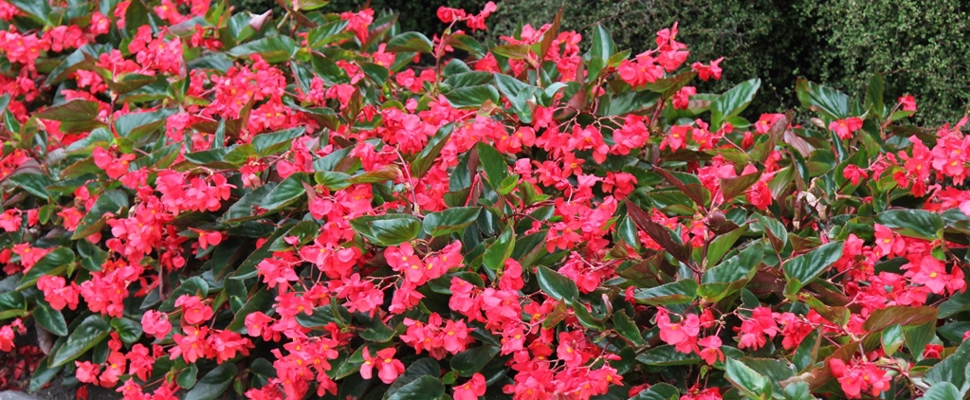
Begonias for summer interest
Annual bedding begonia trial 2017
Introduction
Begonias are a diverse group of plants with various growth habits, many leaf shapes and sizes, leaf colours and patterns. Bedding begonias are mainly grown for their floral displays and some cultivars have attractive shiny, bronze foliage.
At Auckland Botanic Gardens (ABG) we plant annual beds twice a year, unlike many other gardens which plant annual beds three times a year. We therefore require high performing annuals that have long flowering periods. Trialled annuals can indicate the performance these plants would display in mass plantings that are highly visible by the public.
To identify high performing Begonia for summer bedding they must profusely flower for 5-6 months, flowers do not fade and do not need deadheading, the plant gives effective ground cover, and has 100% survival rate, are low maintenance and are pest and disease resistant.
New Begonia cultivars were compared to the known star performer that ABG regularly uses in annual bedding displays, Begonia ‘Dragon Wings Red’. We will assess all cultivars on the following criteria.
- Plant size
- Flowering period
- Flower colour and fade
- Susceptibility to pests and diseases such as powdery mildew
Methods
22 Begonia cultivars were included in trial with one cultivar that ABG knew was a star performer, Begonia ‘Dragon Wings Red’. All cultivars had 10 plants except B. ‘Super Olympia Mixed’ which had 30 plants due to having three colours in the mix. This trial was planted in late November 2016 and concluded mid-April 2017. Plants were composted, fertiliser and deadheaded at the time of planting. Weekly flowering records were collected, noting buds, flowers and old flowers. Monthly assessments of flower colour (using the Royal Horticultural Society colour charts), percentage of plants with powdery mildew and percentage of flowers scorched by sun were collected. Scorching of blooms was recorded by the percentage of flowers scorched using this scale: 1 = no obvious scorching, 2 = 25% of flowers on plant are scorched, 3 = 26-50% scorched; 4 = 51-75% flowers on plant are scorched; 5 = 76-100% scorched. Flower sun scorch was not measured during November as plants had not started flowering. Only once when plants were at maturity, flower size, height and spread of the plants was measured. Plants were watered weekly.
Results
Table 1 Summary results of Begonia trial with an overall performance rating. Cultivars with an overall rating of 8 or higher are recommended as a star performer and indicated by an asterisk.
|
Name |
Flowering |
Habit/form/vigour, size (height by width cm) |
Pests & Disease |
Overall rating |
|
Begonia ‘Big Pink’ |
Mid-Dec to end of April |
Tropical, green foliage. Open habit 32 x 44 |
Clean |
8* |
|
Begonia ‘Big Red’ |
Very slight flower bleaching. End of Dec to end of April |
Tropical foliage 25 x 42 |
Clean |
6 |
|
Begonia ‘Big Rose’ |
Drops flowers. End of Dec to end of April |
Tropical foliage 28 x 46 |
Clean |
6 |
|
Begonia ‘Nightlife Blush’ |
Flower colour fades. Mid-Dec to end of April |
Bronze foliage 24 x 26 |
Powdery mildew |
5 |
|
Begonia ‘Nightlife Deep Rose’ |
Mid-Dec to end of April |
19 x 24 |
Slight powdery mildew |
5 |
|
Begonia ‘Nightlife Pink’ |
Holds old flowers. Mid-Dec to end of April |
Compact 21 x 23 |
Powdery mildew |
5 |
|
Begonia ‘Nightlife Red’ |
Colour fade. Mid-Dec to end of April |
Messy foliage 20 x 28 |
Powdery mildew |
5 |
|
Begonia ‘Nightlife Rose’ |
Holds old flowers. Mid-Dec to end of April |
Compact 23 x 26 |
Powdery mildew |
3 |
|
Begonia ‘Nightlife White’ |
Holds old flowers. Mid-Dec to end of April |
Very bronze foliage 21 x 29 |
Clean |
5 |
|
Begonia ‘Sprint Plus Appleblossom’ |
Mid-Dec to March |
Compact 16 x 27 |
Clean |
5 |
|
Begonia ‘Sprint Plus Blush’ |
Lots of bleached flowers. Mid-Dec to end of April |
Compact 18 x 23 |
Slight powdery mildew |
5 |
|
Begonia ‘Sprint Plus Deep Pink’ |
Mid-Dec to end of April |
20 x 30 |
Clean |
6 |
|
Begonia ‘Sprint Plus Rose’ |
Mid-Dec to end of April |
20 x 32 |
Clean |
5 |
|
Begonia ‘Sprint Plus Scarlet’ |
Faded flowers. Mid-Dec to end of April |
Compact 22 x 25 |
Powdery mildew |
5 |
|
Begonia ‘Sprint Plus White’ |
Lots of bleached flowers. Mid-Dec to end of April |
Compact, holds old leaves 20 x 25 |
Clean |
6 |
|
Begonia ‘Sprint Plus Orange’ |
Mid-Dec to end of Jan, held old flowers till April |
16 x 26 |
Powdery mildew |
3 |
|
Begonia ‘Stara Pink’ |
Mid-Dec to end of April |
Slightly open habit 29 x 41 |
Clean |
7 |
|
Begonia ‘Stara Rose’ |
Mid-Dec to end of April |
Medium vigour, compact 26 x 33 |
Clean |
7 |
|
Begonia ‘Stara Scarlet’ |
Tiny flowers. Mid-Dec to early Feb, held old flowers till April |
Scorched 26 x 38 |
Clean |
7 |
|
Begonia ‘Stara White’ |
Medium white, clean flowers. Mid-Dec to end of April |
Medium vigour, green leaf, red stem 31 x 35 |
Clean |
8* |
|
Begonia ‘Super Olympia Mixed’ |
Flowering not consistent. Mid-Dec to end of April. Mix of red, white and pink flowers. |
Medium vigour, green leaf 26 x 34 |
Clean |
5 |
|
Begonia ‘Dragon Wings Red’ |
Large flowers, later flowering, no flower fade. Late Dec to April. |
Vigorous, less formal 25 x 35 |
Clean |
9* |
NB: some of these cultivars would have continued flowering after April however this is when the trial was removed.
Those cultivars with slight powdery mildew (recorded in Table 1) had 10% or less of the plant affected by powdery mildew. Cultivars with powdery mildew (recorded in Table 1) had 20% or more powdery mildew affecting the plant which is not an acceptable level to be included as recommendations. Most cultivars in this trial did not display significant levels of scorching, i.e. under 25% of plant affected by scorch (Fig 1). No cultivars had more than 50% flower scorch.
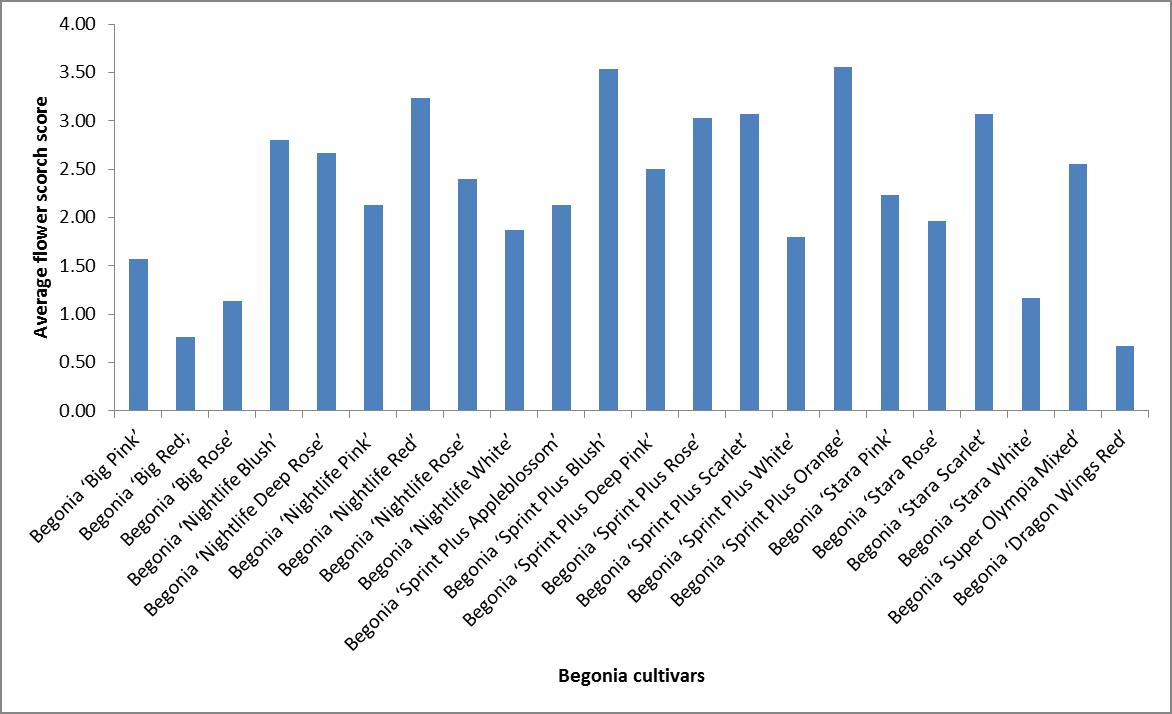
Conclusions
Star performers are B. ‘Big Pink’, B. ‘Stara White’ and B. ‘Dragon Wings Red’. These scored an 8 or higher in the overall rating. They were free of powdery mildew, profuse long flowering period and had the lowest bleaching or flower scorch of all the cultivars trialled. These three star performers are recommended for annual bedding situations as the plants create a good ground cover, therefore minimal weeding around them is required, and meet the requirements of a good annual bedding plant. The cultivars that scored a 7 could be used in garden borders rather than in mass plantings.
All begonias prefer a light loamy soil, high in organic matter low in fertiliser and with free drainage.
Acknowledgments
We would like to acknowledge our summer student Jonathon Parr for collecting data and Egmont Seeds for the recommendations and donation of seeds.
Published article in New Zealand Garden Journal Vol 20(2). This article cannot be republished elsewhere without consent from Auckland Botanic Gardens.
